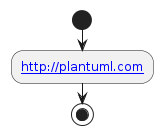-tsvg con la línea de comandos de PlantUML para habilitar la generación SVG. Obtenga más información en nuestra guía de línea de comandos.
format="svg" en su definición de tarea Ant para facilitar la generación de SVG. Encontrará instrucciones detalladas en nuestra guía de tareas Ant.
<target name="main">
<plantuml dir="./src" format="svg" />
</target>
svgLinkTarget setting allows you to modify the target attribute in the hyperlinks generated in the SVG output, thereby controlling how the links will open when clicked.
Referencing the HTML specification, you have the following options:
_blank: Opens the link in a new window or tab_parent: Opens the link in the parent frame_self: Opens the link in the same frame where it was clicked (default setting)_top: Opens the link in the full body of the window_top, applied when the svgLinkTarget is left empty.
The example below uses _parent:

Please note that for SVG links to work properly when the SVG is used in a HTML page, you need to embed the resulting SVG content directly in the HTML page, rather than invoking it through an
<img> tag.
You may also want to use skinparam topurl (see link) to specify how to resolve relative links.
@startuml
skinparam pathHoverColor green
class Foo2 [[http://www.yahoo.com/Foo2]] {
+double[] x
+double y
}
Foo2 --> Foo3
@enduml
[Reference: QA-5453]
style, width, and height attributes in the SVG output header, set the skinparam svgDimensionStyle to false. This gives you cleaner output, focusing solely on the essential elements of your diagram.
@startuml
skinparam svgDimensionStyle false
component a {
}
component b {
}
a -(0- b
@enduml
[Reference QA-7334]
svgSize pragma directive to define custom sizes for specific SVG elements in your PlantUML diagrams.
svgSize Pragma Directive!pragma svgSize <U+hhhhh> XX directive informs PlantUML to assume the size of the <U+hhhhh> element to be the same as the text 'XX' provided.
Here are different ways you can use this directive to obtain the ideal setting:
!pragma svgSize <U+hhhhh> XX!pragma svgSize <U+hhhhh> IsvgSize directive:
@startuml
!pragma svgSize <U+1F610> XX
test: text <U+1F610>
test_size45: text <size:45><U+1F610>
@enduml
svgSize pragma using the -P option on the command-line. Remember to:
java -jar plantuml.jar "-PsvgSize=<U+1F610> XX" "-PsvgSize=<U+1F611> I" -Tsvg <file.puml>
svgInteractive allows you to comprehend better complicated diagrams:
|
🎉 Copied!
|

|
|
🎉 Copied!
|

|
|
🎉 Copied!
|

|